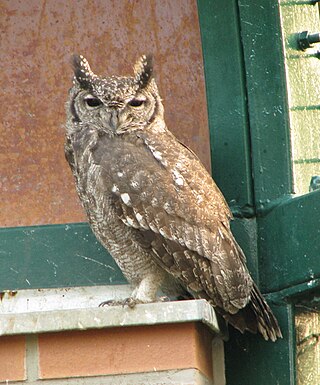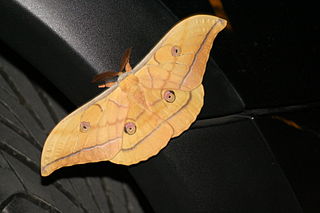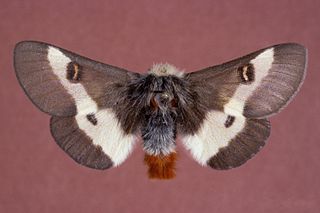
The Party for Democracy, also known as For Democracy is a centre-left political party in Chile. It states to stand in the traditions of liberal progressivism. It was founded in December 1987 by Ricardo Lagos, who aimed at forming a legal social-democratic party, as the Socialist Party of Chile (PS) remained illegal at the time. The PPD continued to function after the defeat of Pinochet. Until 1997, double membership of PPD and the PS was allowed.

Saturniidae, members of which are commonly named the saturniids, is a family of Lepidoptera with an estimated 2,300 described species. The family contains some of the largest species of moths in the world. Notable members include the emperor moths, royal moths, and giant silk moths.

The dryandra moth is a species of moth that is considered to be the sole member of the family Carthaeidae. Its closest relatives are the Saturniidae and it bears a resemblance to many species of that family, bearing prominent eyespots on all wings. The common name is derived from the Dryandra shrubs of the genus Banksia, on which the larva of this species feed, and is hence restricted to the south-west of Western Australia where these shrubs grow. Other Grevillea shrubs may also be used as host plants.

The ash-throated flycatcher is a passerine bird in the tyrant flycatcher family.

Nothoprocta is a genus of birds belonging to the tinamou family Tinamidae. They inhabit scrubland, grassland and open woodland in western South America, particularly in the Andes. They are poor fliers and spend most of their time on the ground. Their diet includes seeds and insects. They nest on the ground, laying large glossy eggs. The eggs are covered with feathers when a potential predator is nearby.

The western banded snake eagle is a grey-brown African raptor with a short tail and a large head. Juveniles have paler and browner upper parts than adults, with white-edged feathers. The eagle's head, neck and breast are dark-streaked. The underparts are white with pale brown streaks, mainly on belly and thighs. Subadults may be all dark grey-brown without any streak on underparts. The eyes, ears, and legs are yellow. They have crested chests.

The Bornean treepie is a passerine bird belonging to the treepies genus, Dendrocitta, of in the crow family, Corvidae. It is endemic to the island of Borneo. It is sometimes treated as a subspecies of the Sumatran treepie.

The greyish eagle-owl or vermiculated eagle-owl is a rather large owl of the northern part of sub-Saharan Africa. It was previously regarded as the northern subspecies of the spotted eagle-owl.

Antheraea yamamai, the Japanese silk moth or Japanese oak silkmoth is a moth of the family Saturniidae. It is endemic to east Asia, but has been imported to Europe for tussar silk production and is now found in southeastern Europe, mainly in Austria, northeastern Italy, and the Balkans. It seems to be spreading north and a population has been reported near Deggendorf and Passau in Germany. The species was first described by Félix Édouard Guérin-Méneville in 1861. It has been hybridized artificially with Antheraea polyphemus of North America.
Tinissa cinerascens is a moth of the family Tineidae. It is found in New Guinea and surrounding islands and from the coasts of Queensland, Australia.

Hemileucinae is a subfamily of the family Saturniidae, including a number of taxa whose caterpillars have venomous urticating hairs.

Automeris is a genus of moths in the family Saturniidae and the subfamily Hemileucinae. As of 1996 there were 124 species, and more have since been described. These moths are generally characterized by the eyelike patches on the hindwings and the leaflike pattern on the forewings, an example of crypsis. The genus was first described by Jacob Hübner in 1819 and it is distributed in the Neotropical realm.

Microdulia is a genus of moths in the family Saturniidae first described by Karl Jordan in 1924. It contains only one species, Microdulia mirabilis, described by Rothschild in 1895, which is found between 35° and 47°S in Chile and Neuquén in Argentina.
Neocercophana is a monotypic moth genus in the family Saturniidae described by Izquierdo in 1895. Its only species, Neocercophana philippii, was described by the same author in the same year. The type specimen was described from Chile.

Polythysana is a genus of moths in the family Saturniidae first described by Francis Walker in 1855.

Samia is a genus of moths in the family Saturniidae. The genus was erected by Jacob Hübner in 1819.

Ligia cinerascens is a woodlouse in the family Ligiidae.

Kyphosus cinerascens is a species of marine ray-finned fish. It is a sea chub from the family Kyphosidae. Kyphosus Cinerascens has 11 dorsal fins and 12 anal fins. Kyphosus cinerascens are widely distributed in the Indo-Pacific region. The Kyphosus cinerascens has a strict diet on phaeophytes, chlorophytes, and rhodophytes, making them herbivores.
This page is based on this
Wikipedia article Text is available under the
CC BY-SA 4.0 license; additional terms may apply.
Images, videos and audio are available under their respective licenses.
















